|
WHEN Dundee fled from the Convention, "Coll of
the Cows," the head of the M'Donalds of Keppoch, was pursuing with
relentless fury the broken host of the Mackintoshes, his ancient
foes, and was, on the arrival of the Viscount in the north,
threatening to sack Inverness. On receiving a large sum of money
from the town, as compensation for alleged injuries, Coll and the
citizens were reconciled through the intervention of Dundee and both
joined in supporting the jacobite interest. An attempt was made to
include the Mackintoshes in the general reconciliation, but Coll
rated his friendship at such a high value as to render the attempt
abortive. The Keppoch Chieftain was so enraged at the refractory
spirit of Mackintosh, that, with the forced connivance of the high-souled
Graham, he drove away all his cattle, most of which were kept among
his own retainers. When Coll took such liberty under the eye of an
energetic general, whose dearest plans were thereby put in peril,
how could he be controlled by the weak, unpopular Cannan? Soon after
the battle of Killiecrankie, several of the clans left the white
standard to go to their several homes with the spoils gathered
during the campaign. Coll of Keppoch left with his own men, and the
M'lans of Glencoe, his confederates, in October. Determined to
gather their winter mart in going home, and aware they could
not do so with any propriety or hope of success in the land of the
Robert sons, who had fought with them under Dundee,
they came round by Glenlyon, and gratified their love of plunder and
their inveterate hatred to the Campbells, by harrying the little
property still possessed by the poor Laird of Glenlyon. The Laird
was completely off his guard ; relying on Can-nan's protection, the
raid of Keppoch was the very last thing he feared. No opposition was
offered to the marauders. The women and cattle were just home from
the sheilings, and the men were peaceably engaged in getting in the
last of the harvest. No sign preceded the storm. The rapacity of the
M'Donalds was unexampled. In one of the huts they found an infant in
a basket cradle, wrapt in a blanket. The child was turned out naked
on the clay floor, and the blanket taken away. One of the Glenlyon
men at the massacre of Glencoe—perhaps, except the Laird, the only
man of them there—as he was slaughtering one of the MTans with the
sword, used, it is said, at each successive thrust, the expressions
of savage revenge—"There for Catherine's blanket!" "There for
Colin's cows!" Colin was the brother of the Laird. Cambuslay, one of
the Brae farms, was the portion allotted him by his father, and, as
it lay conveniently in the way of the M'Donalds, they swept it
clean. This was not the first time that Colin's cows were "lifted"
by the M'Donalds of Glencoe and Lochaber. Robert of Glenlyon and his
brother Colin were minors in 1644-45, when Montrose ravaged and
burned Breadalbane and all the other lands of their maternal
grandfather, Sir Robert Campbell of Glenorchy. The uncle of the
boys, John Tutor of Glenlyon, who afterwards bought the estate of
Duneaves, and founded a family there, was their legal guardian; but
they lived mostly with their mother and her second husband, Patrick
Roy M'Gregor, the landless chief of his clan, at Meggernie Castle,
during their minority. Now Patrick Roy, with a thousand of his clan,
joined Montrose; and so Montrose spared Glenlyon when he despoiled
and burned Breadalbane. But the confederate robbers of Glencoe and
Keppoch—or a small band of them at least— violated the orders of
Montrose, and swept away the cows of young Colin, and some also
belonging to John the Tutor, which were grazing on Colin's lands.
The "banarach bheag," or little dairy-maid, Nic Cree, or M'Cree, who
had charge of the calves, hid them in the rath of Cambuslay, and
secretly followed the robbers to Glenmeuran with the double
intention of recovering the cows and calling out the country. The
poor girl was discovered and killed by the robbers. They had got
hold of the chief dairy-maid, or "banarach mhor" at first, and taken
her captive with them along with the cows. In her captivity this
famed but nameless poetess composed the beautiful song, or lullaby,
of Crodh Chailein, or "Colin's Cows," which has ever since
been used as a charm to make fractious cows give their milk, and
soothe crying babes to sleep. The little dairymaid must have
succeeded before being killed in sending back information about the
robbers and their trail, for it seems they were pursued, and most,
if not all, of the cattle recovered before they could be got into
the Glencoe "Thieves' Corrie," Very probably, the clan M'Gregor who
owed much to the family of Glenlyon, and whose chief was, at this
time, restored to position and fair affluence by his marriage with
the well-dowered widow of Archibald Campbell, younger of Glenlyon,
helped to hunt down the thieves and to recover Colin's cattle. But
the raid, although unsuccessful, was a breach of faith under trust,
and it swelled the already long list of grievous injuries suffered
by Glenlyon at the hands of the M'Donalds of Glencoe and their
kinsmen of Lochaber. Whenever Glenlyon cattle were "lifted" they
were first, unless re-captured on the way, driven to Glencoe, where
they were kept until they could be safely distributed among the
confederates. There was, therefore, a feud of centuries between the
two glens. The modern historians of the massacre of Glencoe
aggravate Robert of Glenlyon's guilt by laying stress on the fact
that Alexander, the son of M'lan, was married to his niece. The
blackest part of the whole business was the treachery planned by the
Government, of which Glenlyon had no notice until the last moment.
But as to the matrimonial relationship, it was thus the matter stood
: Jean Campbell, daughter of Sir Robert Campbell of Glenorchy,
married when very young, Archibald, the heir of Glenlyon, and was
left a widow with two sons, Robert and Colin, when about twenty-five
years old. Shortly afterwards, she married Patrick Roy M'Gregor, to
whom she bore two sons and two daughters. After Patrick's death, she
married Stewart of Appin, and by him had children also. It was to
the Appin family of Glenlyon's mother that Alexander's wife
belonged. The much married lady lived long, and the heavy
settlements made upon her by her first husband and his father, along
with the spend-thrift habits of her son Robert, ruined sadly the,
till then, fairly flourishing Campbells of Glenlyon.
The "creach" of 1689 was not recovered like that
of 1645. The cattle and the spoils were safely got to Glencoe, and
there divided. The following is the list of goods and gear of which
Glenlyon and his tenants were robbed on this occasion. It is
interesting on many accounts, and of especial importance to the
historian of the Glencoe massacre:—
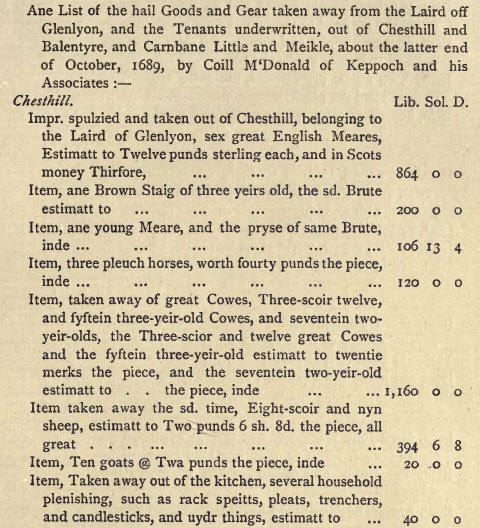

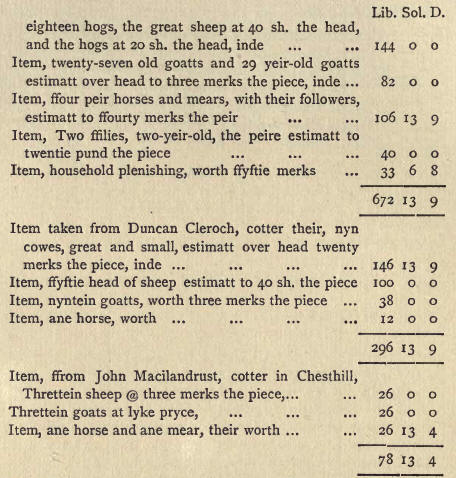
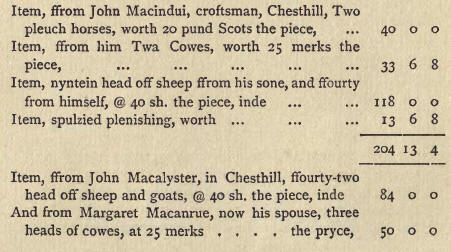
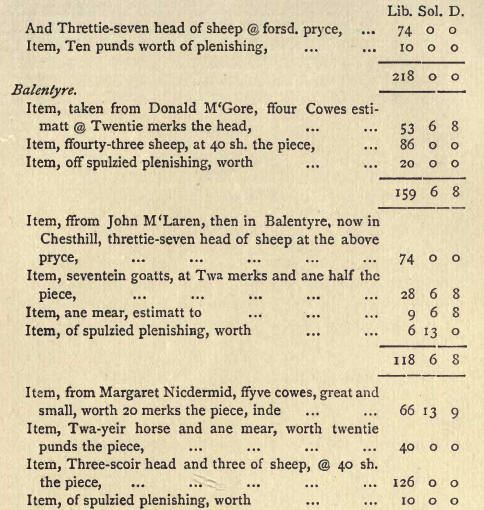
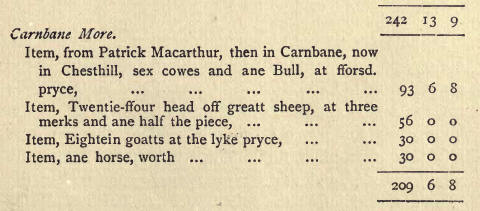
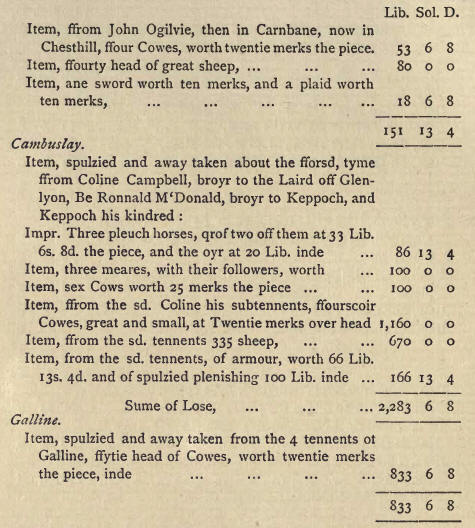
Gallin for whatever reason it is entered in this
list, did not at this time belong to Campbell, but was part of the
property sold to Lord Murray. I do not see how Gallin was spulzied
and the rest of Lord Murray's lands spared, as it is known was the
case. I believe, therefore, the last item refers to some other
foray, which took place before the estate was sold, and that it was
entered at the foot of the more recent claim, as the only desperate
chance of obtain ing
satisfaction. In 1695 an action at civil law was commenced against
Coll of Keppoch by the Lady Glenlyon in the absence of her husband,
but I believe a long bill of costs against her was the only result;
for, though a verdict was easily obtained, "Coll of the Cows," was
not the man to obey implicitly the decree of a judge. Excluding
Gallin from the list, the other farms were held by Campbell in right
of his wife, whose jointure they were, and they formed the whole of
his possessions in Glenlyon. The foray left the laird and his
tenants on the brink of starvation. And that would have been
undoubtedly their fate next year, as, for want of horses, most of
the land lay untitled, had not the laird's son-in-law, Alexander
Campbell of Ardeonaig, stretched his credit with the Laird of
Ochtertyre, from whom he procured meal and grain for Campbell and
his dependents. Any one, by running his eye over the foregoing list,
will understand at once the thorough way in which the Highland
robbers swept a glen. Here, at one fell swoop, a poor landlord and
his few dependents lose their whole stock—all they had in the
world-1—36 horses, 240 cows, 993 sheep, 133 goats, and whatever was
portable of their little household furniture. The money value was
estimated at £7,540 17s. 11d. Scots money, which was a large sum
indeed in those days. Campbell, driven in his old age— he bordered
on 60—to earn his daily bread, resumed his sword and became a
soldier of the Revolution. Early in the year 1690, he obtained a
company in the Earl of Argyle's Regiment of Foot. |

